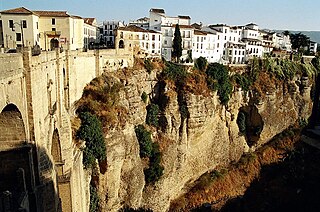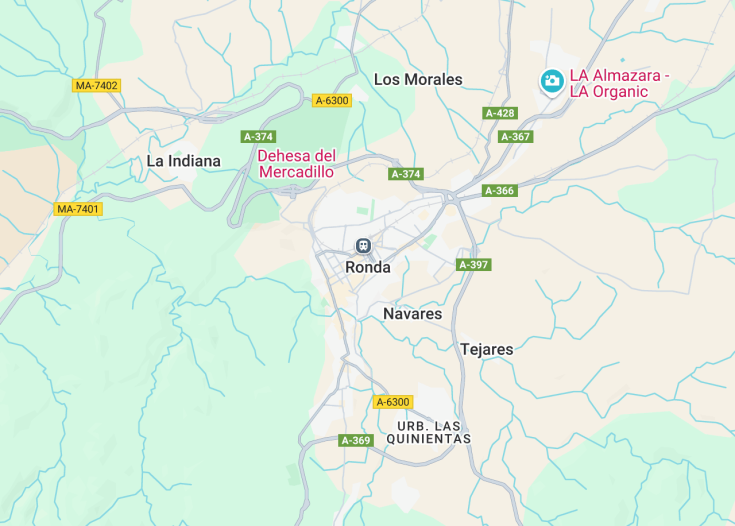Nestled in the mountainous region of Andalusia, Ronda stands as one of Spain’s oldest towns, offering breathtaking views atop its cliffside perch. Known for its historic architecture, including the Puente Nuevo bridge that spans a deep gorge, Ronda merges natural beauty with rich cultural heritage. The town is also celebrated for its role in the development of modern bullfighting, making it a destination that encapsulates both historical significance and stunning landscapes.
For an unforgettable view, visit Ronda during sunset to see how the golden light enhances the town’s ancient stone structures and dramatic cliff faces.
To fully grasp Ronda’s historical essence, ensure a visit to the 18th-century Plaza de Toros, one of Spain’s oldest bullfighting rings, now also a museum.
Top things to do & see in Ronda
Select the following sights and activities to discover best tickets and tours available in Ronda.
Ronda: A Gem Perched in the Andalusian Mountains
| Country | Spain |
| Time in Ronda | GMT+2 |
| Language spoken | Spanish |
| Population | 34,000 (According to the latest data from Spain’s National Statistics Institute) |
| Currency | Euro (€, EUR) |
| Airports |
|
Ronda, a historic city located in the Spanish province of Málaga, Andalusia, is one of Spain’s oldest towns, known for its natural beauty and rich history dating back to the Paleolithic era. This city is dramatically set atop a deep gorge called El Tajo, which separates the old town from the new town, with the famous Puente Nuevo offering a stunning bridge over the chasm.
Ronda is steeped in history, with its origins in the Neolithic age. The city was later fortified by the Romans and subsequently held by Moorish kings until its capture by the Catholic Monarchs in 1485. This layered history is visible in its well-preserved architectural marvels, from medieval Islamic buildings to modern Spanish homes.
Economically, Ronda is driven by tourism with significant contributions from agriculture, craft industries, and winemaking. The surrounding mountainous terrain ensures a thriving olive and grape production, which supports local traditional industries such as wine-making and olive oil extraction.
Apart from its historical and economic significance, Ronda is famous worldwide for its bullfighting tradition. It is considered one of the historical capitals of modern bullfighting, with the annual Feria Goyesca de Pedro Romero attracting enthusiasts from all over the globe. The Corrida Goyesca is a spectacle of traditional costuming and bullfighting held in the oldest bullfighting ring in Spain, the Plaza de Toros de Ronda.
Moreover, Ronda’s cultural scene is vibrant with museums, art exhibitions, and musical performances. The city’s commitment to preserving its historical integrity while nurturing its cultural richness makes it a magnetic spot for visitors looking for a blend of history, culture, and scenic beauty.
Where is Ronda?
Ronda is situated in the heart of Andalusia, Spain, poised on a plateau cut by deep gorges along the Guadalevín River, making it a striking mountain top city.
Distances:
| Route | Distance by car | Time by car |
|---|---|---|
| From Málaga to Ronda | 65 miles (105 km) | 1 hour 30 minutes |
| From Seville to Ronda | 80 miles (129 km) | 1 hour 45 minutes |
| From Jerez to Ronda | 91 miles (146 km) | 1 hour 50 minutes |
What is Ronda famous for?
Ronda is renowned for its breathtaking views and architectural feats like the Puente Nuevo, its ancient bullring, and its significant role in the history of modern bullfighting.
History
Prehistoric to Roman Times
The history of Ronda, located in the province of Málaga, can be traced back to the Neolithic period, where early human settlers were attracted by the natural protection provided by the towering cliffs and El Tajo gorge. Ronda was later inhabited by Celts, who may have named the town ‘Arunda’ in the 6th century BC. The Romans followed, establishing the settlement of Acinipo, known locally as Ronda la Vieja, ‘Old Ronda,’ in the 1st century BC. This became an important city in the region, evident from the remnants of a theatre and other significant Roman structures.
The Moorish Rule (713-1485)
Following the collapse of the Roman Empire, Ronda came under the rule of the Visigoths and subsequently fell into the hands of the Moors in 713. It was during the Islamic dominion that Ronda experienced significant architectural and cultural development, becoming a major city in the emirate of Al-Andalus. The Moors fortified the town and built many of the structures that today epitomize its historical landscape, including the famous Puente Nuevo (New Bridge) which spans the El Tajo gorge. This period came to an end in 1485, when Ronda was captured by the Catholic Monarchs.
Modern and Contemporary Ronda (1485-Present)
Post reconquista, Ronda evolved into a significant cultural and military hub. In the 18th century, the town saw the construction of the New Bridge, completed in 1793, which linked the old Moorish town with the newer parts of the town. The bridge remains an icon of Spanish engineering and a draw for visitors around the globe. Throughout the 19th and 20th centuries, Ronda developed a romantic reputation through frequent mentions in the works of travel writers and novelists like George Eliot and Ernest Hemingway, who were captivated by its dramatic vistas and bullfighting history. Today, Ronda stands as a testament to the various layers of Spanish history, attracting tourists from all over the world who seek to immerse themselves in its unique cultural tapestry.
Visit Ronda
What to see and do in Ronda
Exploring Ronda offers a journey across centuries of history encapsulated within its streets and monuments. Essential visits include the Puente Nuevo, an architectural marvel offering breathtaking views of the El Tajo gorge. The town also boasts the oldest bullfighting ring in Spain, the Plaza de Toros de Ronda, built in 1784. This historic bullring is open to the public as a museum but also hosts occasional bullfighting events. Additionally, visitors should explore the Palacio de Mondragón, a beautifully preserved palace once home to Moorish kings and now housing the municipal museum which showcases Ronda’s rich history. For nature enthusiasts, Ronda serves as a gateway to the Sierra de las Nieves Natural Park, ideal for hiking and observing local wildlife.
Festivals and Traditions
Ronda is rich in cultural traditions, highlighted by its annual Feria Goyesca. Held in September, this event sees the town step back into the late 18th century, with people dressed in period costumes and a week filled with bullfighting, horse parades, and traditional dances. Another significant event is the Holy Week (Semana Santa), a solemn yet captivating affair with processions that illustrate the town’s deep religious roots.
Best time to visit Ronda
The best time to visit Ronda is during spring (April to June) or fall (September to October). These months offer mild weather, fewer crowds, and the natural beauty of the surrounding landscapes at their peak. Additionally, visiting during these periods aligns with some of Ronda’s notable cultural events, enhancing the travel experience.
Is Ronda worth visiting?
Ronda is undeniably worth visiting. This town not only offers a rich tapestry of historical and cultural attractions but also captivates with its stunning natural environment. From its dramatic cliffs and ancient bridges to its historic bullring and lively cultural festivals, Ronda presents a unique blend of history, art, and nature, making it a quintessential Spanish destination.









